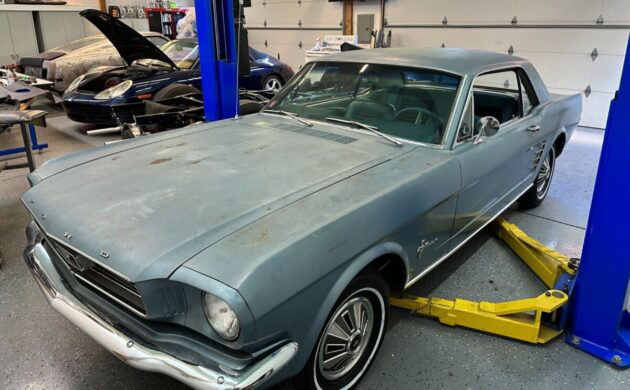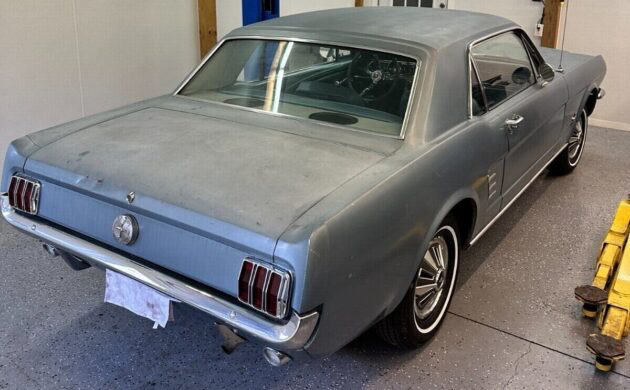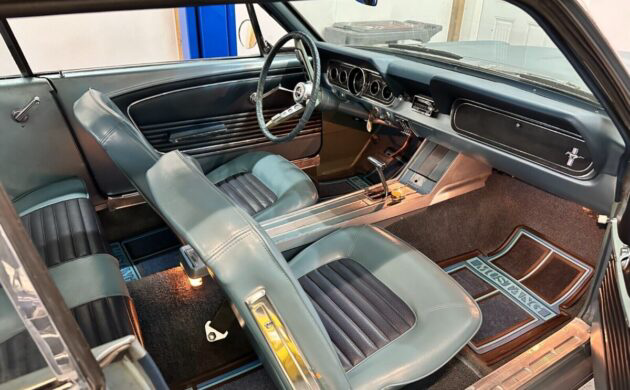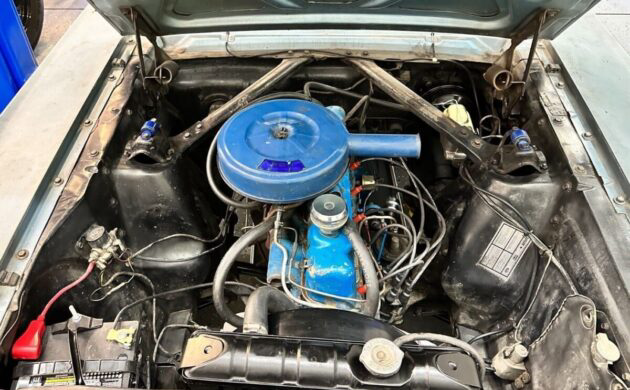The 1966 model year holds the record for the American public’s love affair with the Ford Mustang. That year, more than 607,000 copies were built, far exceeding anything before or after. Beginning in 1967, serious competition would begin to arrive in the “pony car” space (Chevy Camaro, Pontiac Firebird, etc.). This ’66 Mustang is very much like the one I had (and wish I still did): a 6-cylinder engine, automatic, transmission, and a console. With a lot of recent mechanical refreshing, this pony car is in Pepperell, Massachusetts, and is available here on eBay where the reserve is unmet at $7,900.
From its introduction in April 1964 at the New York World’s Fair, Ford couldn’t build enough Mustangs during its first 2 ½ years. By the time the curtain fell on the 1966 season, 1.3 million of them had been produced – can you imagine the amount of overtime that was put on by the assembly lines to get a job like that done? Changes for 1966 would be subtle – different grille, gas cap, wheel covers, etc. It would not be until 1967 that the Mustang saw its first serious adjustments, including an expansion of the engine compartment to accept 390 cubic inch V8s.
This ’66 Mustang didn’t come with a long list of options. A basic 200 CI is under the hood with an automatic tranny instead of a 3-speed manual. That would have been good for at least 25 mpg on the highway at 55-60 mph (remember the temporary lowering of speed limits after the 1973 OPEC oil embargo?). The interior of this Silver Blue Mustang looks impeccable, thanks no doubt to it being in a heated garage for more than three decades.
Prior ownership of this car isn’t noted, so we assume the seller found it to fix up and then pass it along to someone else to enjoy. The list of new parts is rather extensive and includes the fuel tank, carburetor, brakes (including the master cylinder), radiator, exhaust manifold, tires, and more. All the fluids have been changed and a complete tune-up conducted. We assume it runs well now. The only negative is the original paint which is past its prime on upward-facing sheet metal and comes with a little surface rust and minor dings. This little Ford brings back some great memories. Did you have one of these Mustangs, too?





I’ve had 2 ’66 Mustangs, both in red, both before I was 25! I hope to get one for my daughter’s first car. She’s only seven, so I’ve got some time, but this is a nice one.
I’ve had two also, a 65 and a 66. My parents bought a new 66 when I was 5. We were on vacation and my father convinced my mother to “just to stop and look”… Needless to say, we drove home in a new Mustang (silver with a red interior + console). It was a great car – wish we still had it!
I like it but I think at $7900 bucks it is at the top of what I would be willing to pay and it still hasn’t hit the reserve
Pictures of the car on a lift but, doesn’t have any of the floor pan? Who does that?
If my pc’s monitor is telling me correctly, that color should be Brittany Blue, with a med / light metallic blue interior. I had a ’68 “A” program car outfitted just like this that I bought new. By then, you got a “c” stripe in white, base 3-speed manual, turn signals in the hood, and that’s it. I took mine to the vinyl top shop across town, after stopping at the Courtesy’s parts counter for the chrome trim at the bottom of the “c” pillar. all total: $2,368.00. I had to bag groceries for two years to pay for it.
I thought engine bay expansion for a 390 was in ‘67? But I could be wrong
I had a 65, 66 and a 68 Mustang. I loved the 68 fastback as it had a 302 engine 4 barrel carb, 4 on the floor and bright red. What was I thinking when I sold them?
I actually have a 66 in that color. Official name was Tahoe Turquoise.
Mine is also the 6 cylinder but with an all black interior. That engine compartment picture looks funny, though. Is that some kind of cowling around the radiator fan? I’ve never seen that in this year…
Yes, you are correct. It was in the 67 model year that the big 390 engine became avail. as an option. The article above just mentioned it. The Ford designers/ engineers widened the car about 2 inches, lengthened it about 2 inches, and added a torque box underneath the left side to add rigidity to the structure.